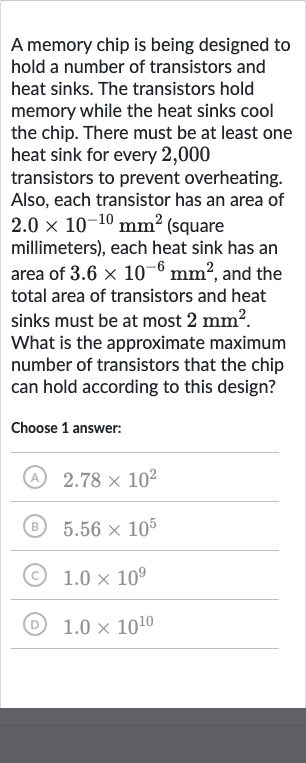AI tutor
Welcome to Bytelearn!
Let’s check out your problem:

A memory chip is being designed to hold a number of transistors and heat sinks. The transistors hold memory while the heat sinks cool the chip. There must be at least one heat sink for every transistors to prevent overheating. Also, each transistor has an area of (square millimeters), each heat sink has an area of , and the total area of transistors and heat sinks must be at most . What is the approximate maximum number of transistors that the chip can hold according to this design? Choose answer: (A) (B) (C) (D)
Full solution
Q. A memory chip is being designed to hold a number of transistors and heat sinks. The transistors hold memory while the heat sinks cool the chip. There must be at least one heat sink for every transistors to prevent overheating. Also, each transistor has an area of (square millimeters), each heat sink has an area of , and the total area of transistors and heat sinks must be at most . What is the approximate maximum number of transistors that the chip can hold according to this design? Choose answer: (A) (B) (C) (D)
- Constraints: Understand the constraints for the memory chip design.- There must be at least one heat sink for every transistors.- Each transistor has an area of .- Each heat sink has an area of .- The total area for transistors and heat sinks must be at most .
- Equations Setup: Let be the number of transistors and be the number of heat sinks. According to the constraints, we have:
- Total Area Inequality: Express the total area in terms of and and set up the inequality based on the maximum area allowed.Total area = (Area of one transistor Number of transistors) + (Area of one heat sink Number of heat sinks)Total area = Total area
- Substitution: Substitute the relationship between and into the total area inequality.Since , we can use in the inequality:
- Solving for T: Simplify the inequality to solve for T.
- Final Answer: Choose the answer that is closest to the maximum number of transistors without exceeding it.The closest answer that does not exceed is:(C)
More problems from Solve quadratic equations: word problems
QuestionGet tutor help
QuestionGet tutor help
QuestionGet tutor help
QuestionGet tutor help
QuestionGet tutor help
QuestionGet tutor help
QuestionGet tutor help
QuestionGet tutor help
